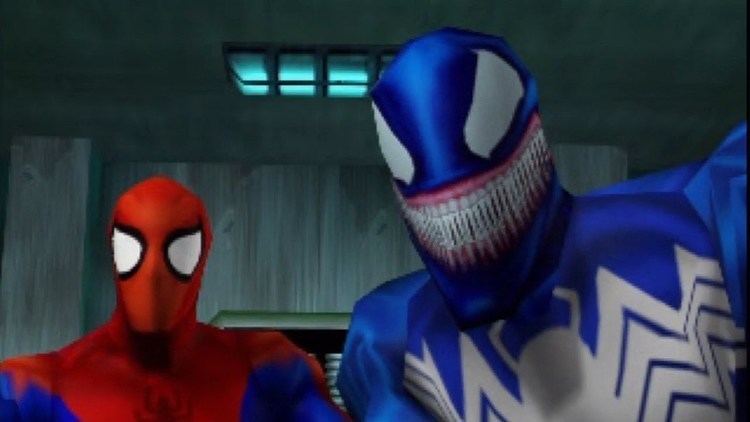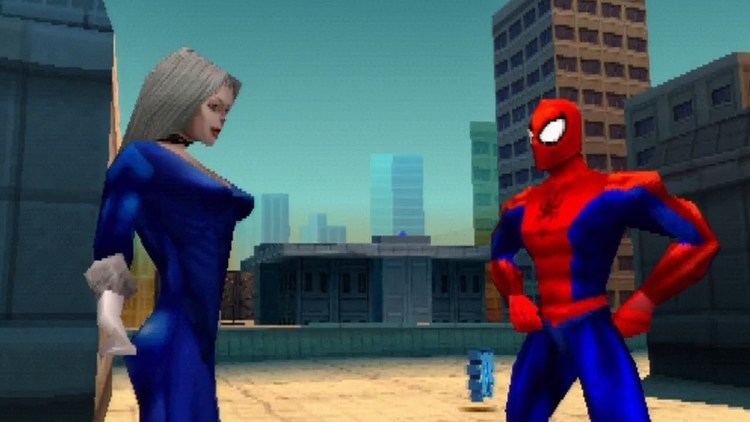9 /10 1 Votes
Designer(s) Chad Findley Artist(s) Chris Ward | 9/10 IGN Producer(s) Kevin Mulhall Programmer(s) Dave Cowling Initial release date 30 August 2000 | |||||||||||||||||||||||||||||||||
 | ||||||||||||||||||||||||||||||||||
Composer(s) Tommy TallaricoHoward Ulyate Developers Neversoft, Treyarch, Vicarious Visions, Edge of Reality, Gray Matter Interactive, LTI Gray Matter Similar Activision games, Beat 'em up games | ||||||||||||||||||||||||||||||||||
Spider-Man is an action-adventure beat 'em up video game based on Marvel's Spider-Man.
Contents
It was developed by Neversoft and published by Activision for the PlayStation in 2000; the game was later ported by different developers to various systems including the Game Boy Color and Nintendo 64 that same year, as well as the Dreamcast and Microsoft Windows in 2001. Two direct sequels were released in 2001; one developed by Torus Games, Spider-Man 2: The Sinister Six, released for the Game Boy Color, and one developed by Vicarious Visions, Spider-Man 2: Enter Electro, released for the PlayStation.

Vicarious Visions developed the Game Boy Color version, Edge of Reality developed the Nintendo 64 version, Treyarch developed the Sega Dreamcast version, and LTI Gray Matter developed the Windows version of the game.

Plot
A supposedly reformed Dr. Otto Octavius is holding a scientific demonstration at Science Expo 2000, in New York City, but is interrupted when an impostor Spider-Man attacks the crew and steals his equipment. Eddie Brock tries to take pictures for J. Jonah Jameson of the Daily Bugle, but the impostor shatters his camera. In rage, the Venom symbiote surfaces inside him, and he swears revenge on both Jameson and Spider-Man. Peter Parker (the real Spider-Man, in attendance) is framed for the incident and the police begin to track him down. Meanwhile, two shadow figures working together poison the entire city with a deadly fog.
After meeting Black Cat and foiling a robbery by the Jade Syndicate, Spider-Man rushes to the Daily Bugle, where he fights and defeats Scorpion to keep him from killing Jameson, only for Jameson to send the police after him. He encounters Daredevil, who promises to spread the word about Spider-Man's innocence. After evading a police chopper, Spider-Man reunites with Black Cat, who alerts him to two new problems: a power plant (Omni-Tech) being attacked by Rhino, and Venom holding his wife Mary Jane Parker hostage to lure Spider-Man. Spider-Man refuses to abandon Black Cat and goes with her to the power plant. Spider-Man defeats Rhino, but Black Cat is injured and kidnapped by Doctor Octopus (Octavious' split personality) and Carnage disguised as paramedics.
After encouragement from the Human Torch, Spider-Man sets out to find Venom, only for him to appear behind him and lead Spider-Man on an elaborate chase into the sewer. Spider-Man comes across the imprisoned Lizard, who explains that Venom locked him up and took control of his lizard men, and points him in the direction of Venom's lair where Mary Jane is being kept. After defeating Venom and rescuing Mary Jane, Spider-Man convinces Venom that someone has framed him and that they have deliberately been turned against each other. To make amends, Venom decides to aid Spider-Man, and they head for the Daily Bugle to search through Jameson's files to try and find the impostor's identity.
During the search, Venom senses the presence of Carnage, and leaves to find him and keep him away from Spider-Man. After fighting through an infestation of symbiotes throughout the building, Spider-Man finally locates the identity of his impostor: Mysterio. After being defeated by Spider-Man, Mysterio reveals his boss's plan: to infest New York with symbiotes, with the fog over the city acting as a beacon for the symbiotes that will prepare the citizens for symbiosis. Mysterio's information leads Spider-Man to Warehouse 65, which hides an enormous underground base where the symbiotes that are cloned from Carnage's symbiote are being manufactured. Spider-Man runs into the Punisher, and with his help, finds a path leading into an undersea base.
After rescuing Black Cat, Spider-Man finally discovers that Octavius and Carnage are the masterminds behind the plan. Taking up his Octopus persona once again, he explains that he feigned reform and is planning to rule the new world he plans to create via symbiosis, and kill those who oppose him. As Venom appears and takes on Carnage, Spider-Man battles Octopus. Despite Octopus being protected by a force field, Spider-Man defeats him. Carnage defeats Venom, forcing Spider-Man to fight the symbiote himself. He manages to defeat Carnage with sonics, but his symbiote fuses with Octopus to produce an enormous, out-of-control monster called "Monster Ock". Spider-Man escapes Monster Ock in a long chase, and the base is destroyed. Spider-Man carries Octopus to the surface, where he is rescued by Captain America, who was called by Black Cat and Venom, while the Carnage symbiote escapes.
In the epilogue, Spider-Man is shown playing cards with Captain America, Daredevil, and the Punisher, while Black Cat and the Human Torch are dancing. In prison, Mysterio, Rhino, Scorpion, and a Jade Syndicate thug are also playing cards while Octopus is banging his head on the cell bars. Scorpion openly mocks them for failing to defeat Spider-Man despite all working together.
Development
Spider-Man uses the same game engine as Tony Hawk's Pro Skater. Spider-Man was a hidden character in Tony Hawk's Pro Skater 2, and a reference is made to this during gameplay. The PlayStation, Dreamcast, and Windows versions have pre-rendered cutscenes, whereas the Nintendo 64 version shows captioned freeze-frames done in the style of a comic book and with fewer voice clips, due to that console's technical limitations for cutscenes. The Lizard was meant to appear in the final cutscene but was not included in the final version of the game's cutscene. The Nintendo 64 version is colloquially referred to as Spider-Man 64.
Audio
Some of the voice actors from both the 1990s Spider-Man and Spider-Man Unlimited cartoons reprise their respective roles. For instance, Rino Romano reprises his role as Spider-Man from Spider-Man Unlimited, Efrem Zimbalist, Jr. reprises his role as Doctor Octopus from the 1990s Spider-Man cartoon, and Jennifer Hale reprises her roles as both Black Cat from the 1990s Spider-Man cartoon and Mary Jane Watson from Spider-Man Unlimited. The main song is a "rock n' roll" remix of the 1960s Spider-Man cartoon.
Gameplay
The game has the player controlling Spider-Man as he goes through each level, either trying to reach the exit or complete a certain objective. The player must restart the current level if Spider-Man runs out of health, falls off a building, or fails to complete certain objectives such as rescuing a hostage. Spider-Man is able to utilize his spider powers to traverse the environments, being able to crawl on walls and ceilings, swing short distances and instantly zip between certain points. In combat, Spider-Man can utilize a limited supply of web-cartridges to attack his enemies, either webbing them up to stall or defeat them, increasing the strength of his attacks, or forming an explosive barrier. Spider-Man can also find power-ups such as Spider-Armor which temporarily increases his strength and defense, and Fire Webbing which is effective against symbiotes.
Alternate costumes
There are variety of different costumes that span the course of Spider-Man's career featured in the game, each one achieved by accomplishing various goals or by entering in a cheat code. While some are just alternate character skins, others give Spider-Man new abilities. These costumes include the Symbiote, Spider-Man Unlimited, street clothes, Quick-Change Spider-Man, Amazing Bag-Man, Spider-Man 2099, Scarlet Spider, Ben Reilly, and Captain Universe versions. Every time the game is completed, another costume will be unlocked.
Soundtrack
The game's soundtrack was composed by Tommy Tallarico. It features a variation of musical loops mostly influenced by popular genres of the time, such as industrial rock and nu metal. The Nintendo 64 version includes a sound test where individual samples of tracks can be listened to.
Reception
Spider-Man received critical acclaim. GameRankings shows aggregate scores of 86.53% for the PlayStation version, 66.91% for the Game Boy Color version, 82.52% for the Nintendo 64 version, 80.23% for the Dreamcast version, and 67.96% for the PC version. Metacritic shows scores of 87 out of 100 for the PlayStation version, 72 out of 100 for the Nintendo 64 version, 80 out of 100 for the Dreamcast version, and 68 out of 100 for the PC version.
IGN gave the PlayStation version a 9 out of 10, calling it "arguably, the best Spider-Man game". GameSpot gave the same version a 7.7, calling it "excellent framework on which to base future Spider-Man games – and an exceptional game to boot".
